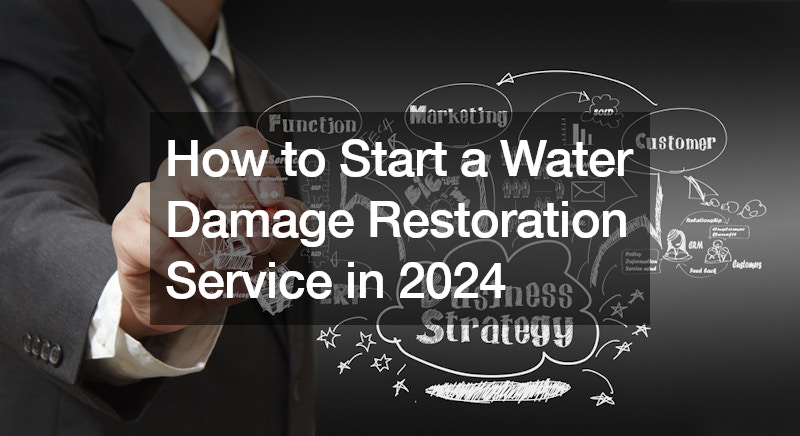Starting a water damage restoration business requires careful planning, strategic decision-making, and a solid understanding of the industry landscape. With the right approach, aspiring entrepreneurs can establish a successful and profitable venture in this growing field. Here’s a comprehensive guide on how to launch a water damage restoration business in 2024.
1. Research and Education
Before diving into the restoration industry, it’s essential to conduct thorough research to understand the market demand, competition, and regulatory requirements. Familiarize yourself with the latest trends, technologies, and best practices in water damage restoration services.
Additionally, invest in education and training to acquire the necessary skills and certifications. Obtain certifications such as Water Damage Restoration Technician (WRT) and Applied Structural Drying (ASD) to demonstrate your expertise and credibility in the field.
2. Strategic Planning
Develop a detailed business plan outlining your goals, target market, services offered, pricing structure, marketing strategies, and financial projections. Identify your niche within the water damage restoration sector, whether it’s residential, commercial, or specialized services like mold remediation or fire damage restoration.
Consider factors such as startup costs, operational expenses, insurance requirements, and legal considerations. Determine the initial capital needed to launch your business and explore financing options if necessary.
3. Funding Your New Business
Starting a water damage restoration service in 2024 requires careful planning, dedication, and financial resources. Funding is a crucial aspect of launching any new venture, and there are several options available to aspiring entrepreneurs.
- Personal Savings: Many entrepreneurs choose to fund their new businesses using personal savings. This approach offers the advantage of complete control over the funds and avoids the need to take on debt or give up equity in the business. However, it may require significant savings or liquid assets to cover startup costs.
- Small Business Loans: Traditional bank loans, Small Business Administration (SBA) loans, or loans from alternative lenders are common sources of funding for new businesses. These loans typically require a solid business plan, good credit history, and collateral. While loans provide access to capital, they also come with repayment obligations and interest expenses.
- Investors: Some entrepreneurs seek investment from angel investors, venture capitalists, or other private investors to fund their startups. In exchange for funding, investors may receive equity in the business or expect a return on their investment over time. This option can provide access to larger amounts of capital but may involve giving up some control of the business.
4. Branding and Marketing
Establish a strong brand identity that resonates with your target audience. Choose a memorable business name and create a professional logo and visual assets. Develop a compelling value proposition highlighting the benefits of your water damage restoration service.
Invest in a user-friendly website that showcases your services, testimonials, and contact information. While a website is important for establishing an online presence, prioritize other marketing efforts such as networking, referrals, and local partnerships to generate leads and build credibility within your community.
5. Equipment and Resources
While it may be tempting to invest in equipment right away, prioritize understanding your specific needs before making purchases. Consult with industry experts or experienced professionals to determine the essential equipment required for your water damage restoration business. This may include moisture meters, dehumidifiers, air movers, extraction tools, and protective gear.
Consider leasing equipment initially to minimize upfront costs and ensure flexibility as your business grows. Focus on acquiring high-quality, reliable equipment that meets industry standards and enhances the efficiency of your restoration processes.
6. Legal and Insurance Considerations
Ensure compliance with local regulations and obtain the necessary licenses and permits to operate your water damage restoration business legally. Consult with a legal advisor or business consultant to navigate the regulatory landscape and establish a solid legal framework for your operations.
Additionally, invest in comprehensive insurance coverage to protect your business, employees, and clients against potential liabilities and unforeseen circumstances. Consider obtaining general liability insurance, workers’ compensation insurance, and professional liability insurance tailored to the specific risks of the restoration industry.
7. Ongoing Education and Professional Development
Stay updated on industry advancements, regulations, and best practices through ongoing education and professional development. Participate in workshops, seminars, and industry conferences to expand your knowledge, network with peers, and stay ahead of the competition.
Invest in training programs for your team members to ensure they are equipped with the latest techniques and skills in water damage restoration services. Continuously evaluate and improve your processes to deliver exceptional service and exceed customer expectations.
8. Providing Exceptional Service
Ultimately, the success of your water damage restoration business hinges on delivering exceptional service and exceeding customer expectations. Focus on providing prompt, reliable, and professional service to clients in their time of need. Prioritize transparency, communication, and empathy throughout the restoration process to build trust and long-term relationships with your customers.
By following these steps and staying committed to excellence, aspiring entrepreneurs can successfully launch and grow a thriving water damage restoration business in 2024. Embrace innovation, adapt to market trends, and prioritize customer satisfaction to differentiate your business and position it for long-term success in the competitive restoration industry.
.


